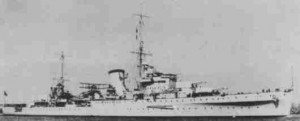- Author
- Atwill, R., DSM, Lieutenant, RN (Rtd)
- Subjects
- None noted
- Tags
-
- RAN Ships
- None noted.
- Publication
- December 1971 edition of the Naval Historical Review (all rights reserved)
In this article Lieutenant Atwill describes the holocaust of the evacuation of Heraklion, Crete. HMS Orion, a cruiser of the Leander class, flying the flag of Admiral Sir Bernard Rawlings led a force composed of HM Ships Ajax, Dido, Decoy, Jackal, Imperial, Hotspur, Kimberley and Hereward to embark a force of 4,500 Australian and United Kingdom troops from Heraklion on the night of 28th-29th May 1941. The evacuation was achieved without incident, but the fleet was savagely attacked by the Luftwaffe on the return voyage. Orion, although severely damaged, her captain dead and 500 dead between decks, survived to limp into Alexandria. Lieutenant Atwill’s first hand account graphically recalls the tribute paid by the Navy in the Greek and Crete Campaigns.
NOW WE KNEW! We looked around at our little fleet of ships – the cruisers Orion, Ajax and Dido and six destroyers – not too many for the huge job in front of us! We were bound for Heraklion.
Air attacks began at 1700, when our force was 90 miles from Scarpanto, the enemy air base in the Dodecanese. At 1920 the Imperial, one of the destroyer escorts, was narrowly missed by a bomb, and at 8.10 p.m. the cruiser Ajax was more narrowly missed, being damaged above the waterline and sustaining a number of casualties. As soon as it was dark, she was ordered back to Alexandria – this was no venture for a lame duck. The force reached Heraklion at 2330. The two cruisers Orion and Dido remained off the entrance, while the destroyers, four at a time, filled to capacity alongside the pier and transferred the troops to the cruisers. Embarkation was completed by 0300 on 29th May, when the destroyers Kimberley and Imperial cleared the harbour carrying the entire rearguard. Except for wounded in hospital too ill to be moved, not one British soldier was left behind. Included in Orion’s share of the troops was a Greek sergeant, his wife and baby daughter and his sister – they were accommodated in the Captain’s day cabin aft.
Although the embarkation had been carried out smoothly, from then on things for Admiral Rawlings in Orion did not go so smoothly.
Three quarters of an hour after leaving Heraklion, the Imperial’s steering gear broke down as a result of the near miss of the previous day. We were still off a hostile shore, and if we were to run the gauntlet of the Kaso Strait under protection of darkness, there was no time to lose. The destroyer Hotspur was ordered to embark Imperial’s complement, which included part of the rearguard, and sink her. This she did, rejoining the squadron with 900 men onboard just after sunrise. Speed was increased to maximum, but the morning sun revealed us one and a half hours behind our programme. As we turned southward into Kaso Strait, attacks from Junkers began with grim savagery.

At 0625 the Hereward was hit by a bomb and fell out of line. To linger so close to enemy air bases with ships crowded with troops was to invite further disaster. Admiral Rawlings had no alternative but to steel his heart and hold to his Heraklion course and speed. When last seen Hereward was making slowly for Crete five miles away, every gun in action fighting to the last against attacking aircraft. The majority of her officers and men survived as prisoners of war. Their ship sank.
Only six weeks before she had rescued me and many of the ship’s company of the cruiser HMS Bonaventure after we had been torpedoed and sunk by an Italian submarine.




